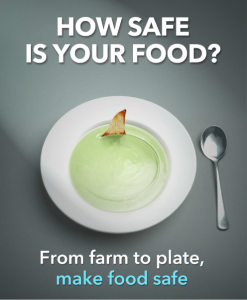 I often hear people tell me they had the flu because symptoms lasted 24 hours. However, I think that many may not understand. Let me explain…
I often hear people tell me they had the flu because symptoms lasted 24 hours. However, I think that many may not understand. Let me explain…
Stomach pains, slight fever, and, in more severe cases, vomiting and/or severe diarrhea, are actually symptoms of ingesting contaminated food. We are at risk of food contamination when we eat food that’s been prepared improperly, eat something that’s been cross-contaminated with raw food, or eat using utensils that have not been thoroughly sanitized. Unsafe food can lead to a range of health problems, including diarrhoeal disease, viral disease (the first Ebola cases were linked to contaminated bush meat), cancers, and reproductive and developmental problems.
In fact,
food-related diseases are so prevalent that the topic for the World Health Organization’s (WHO) World Health Day was
Food Safety – From Farm To Plate. As a result of the more than 200 diseases caused by food contamination, the WHO is pushing to better educate people on properly managing, packaging, shipping, purchasing, and preparing food crops. When you think about the assembly line of folks that it takes to organize getting your food from the farm to your plate, you can begin to appreciate the myriad of opportunities there are for your food to be handled improperly or to become contaminated. Changes in food production, distribution and consumption (i.e. intensive agriculture, globalization of food trade, mass catering and street food); changes to the environment; new and emerging bacteria and toxins; antimicrobial resistance—all increase the risk that food becomes contaminated.
That being said, let’s discuss what influenza truly looks like.
Seasonal influenza is an acute viral infection caused by an influenza virus. There are 3 types of seasonal influenza viruses – A, B and C. Type A influenza viruses are further classified into subtypes according to the combinations of various virus surface proteins. Among many subtypes of influenza A viruses, influenza A(H1N1) and A(H3N2) subtypes, are currently circulating among humans.
Influenza viruses circulate in all parts of the world. Type C influenza cases occur much less frequently than A and B. That is why only influenza A and B viruses are included in seasonal influenza vaccines.
Signs and Symptoms Of Seasonal Flu
Seasonal influenza is characterized by a sudden onset of high fever, cough (usually dry), headache, muscle and joint pain, severe malaise (feeling unwell), sore throat and runny nose. Cough can be severe and can last 2 or more weeks. Most people recover from fever and other symptoms within a week without requiring medical attention. However, influenza can cause severe illness or death, especially those at high risk (infants, elderly and the immunocompromised). The time from infection to illness, known as the incubation period, is about 2 days.
Contact me with any questions you may have or to further discuss at docsage@docsage.com.
Be Your Best Health,
Dr. Sage Campione
Did you enjoy this article? Why not share it with others? Simply click below to share on Facebook or Twitter.
 I often hear people tell me they had the flu because symptoms lasted 24 hours. However, I think that many may not understand. Let me explain…
I often hear people tell me they had the flu because symptoms lasted 24 hours. However, I think that many may not understand. Let me explain…





